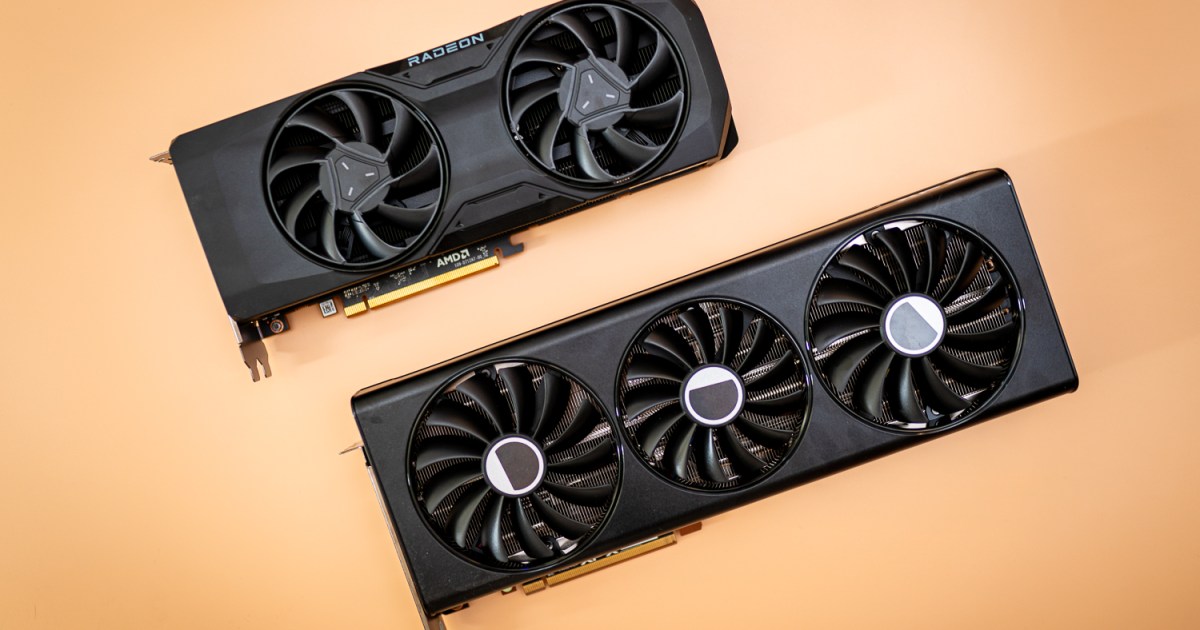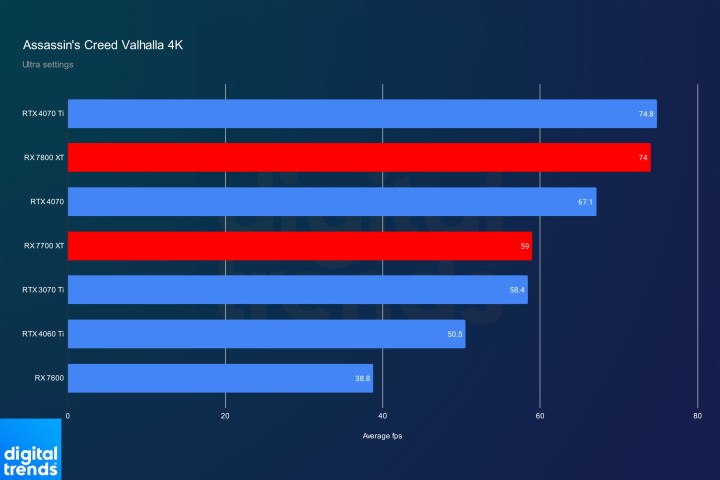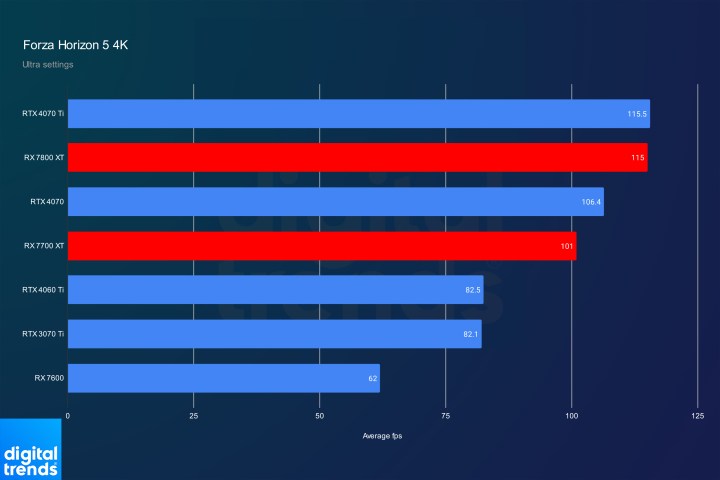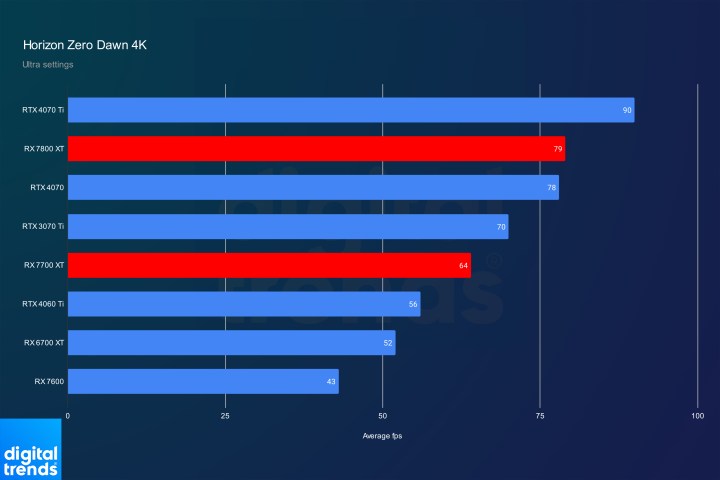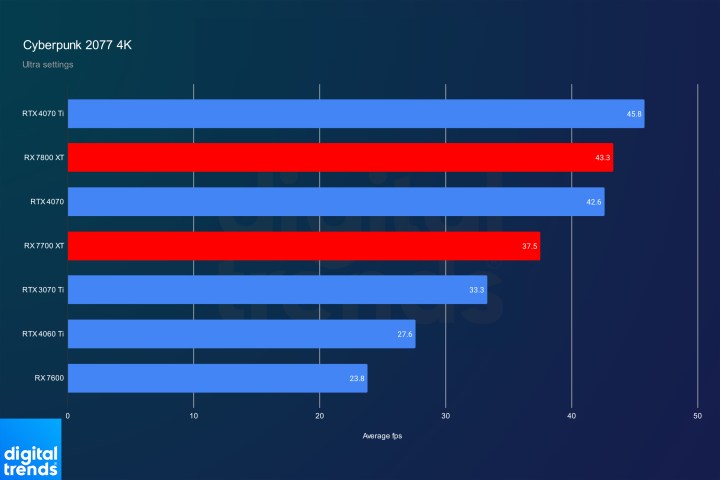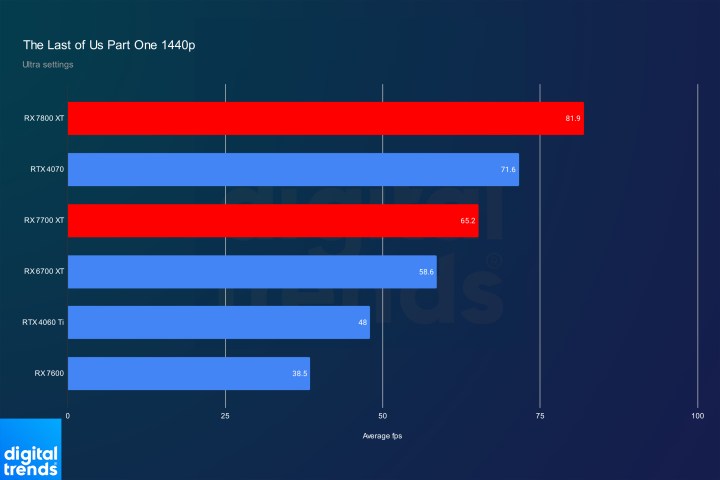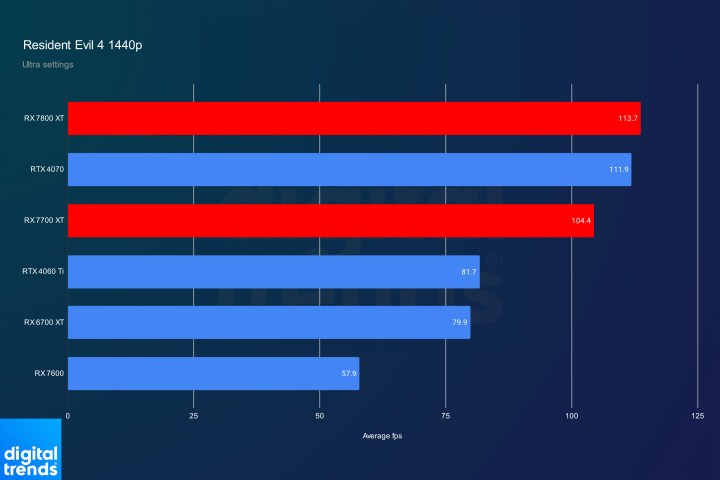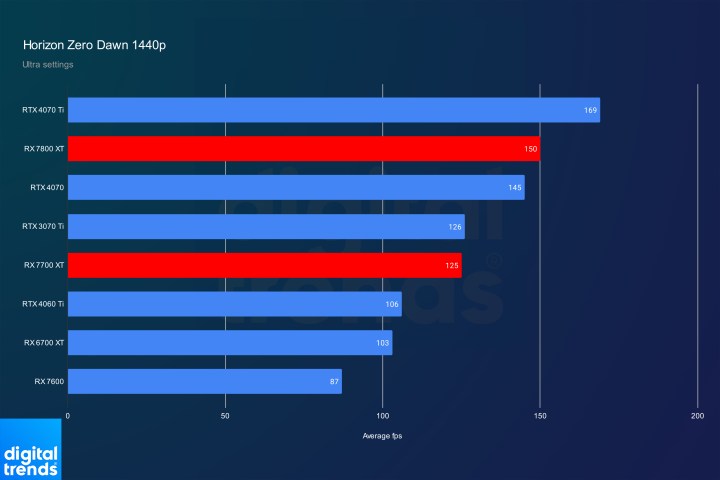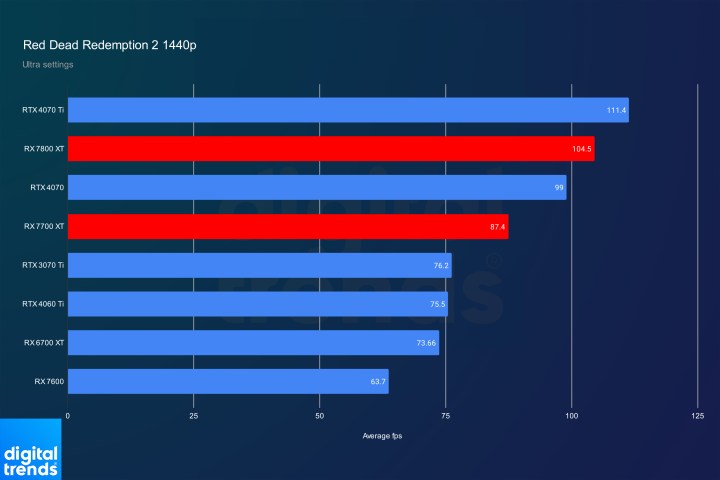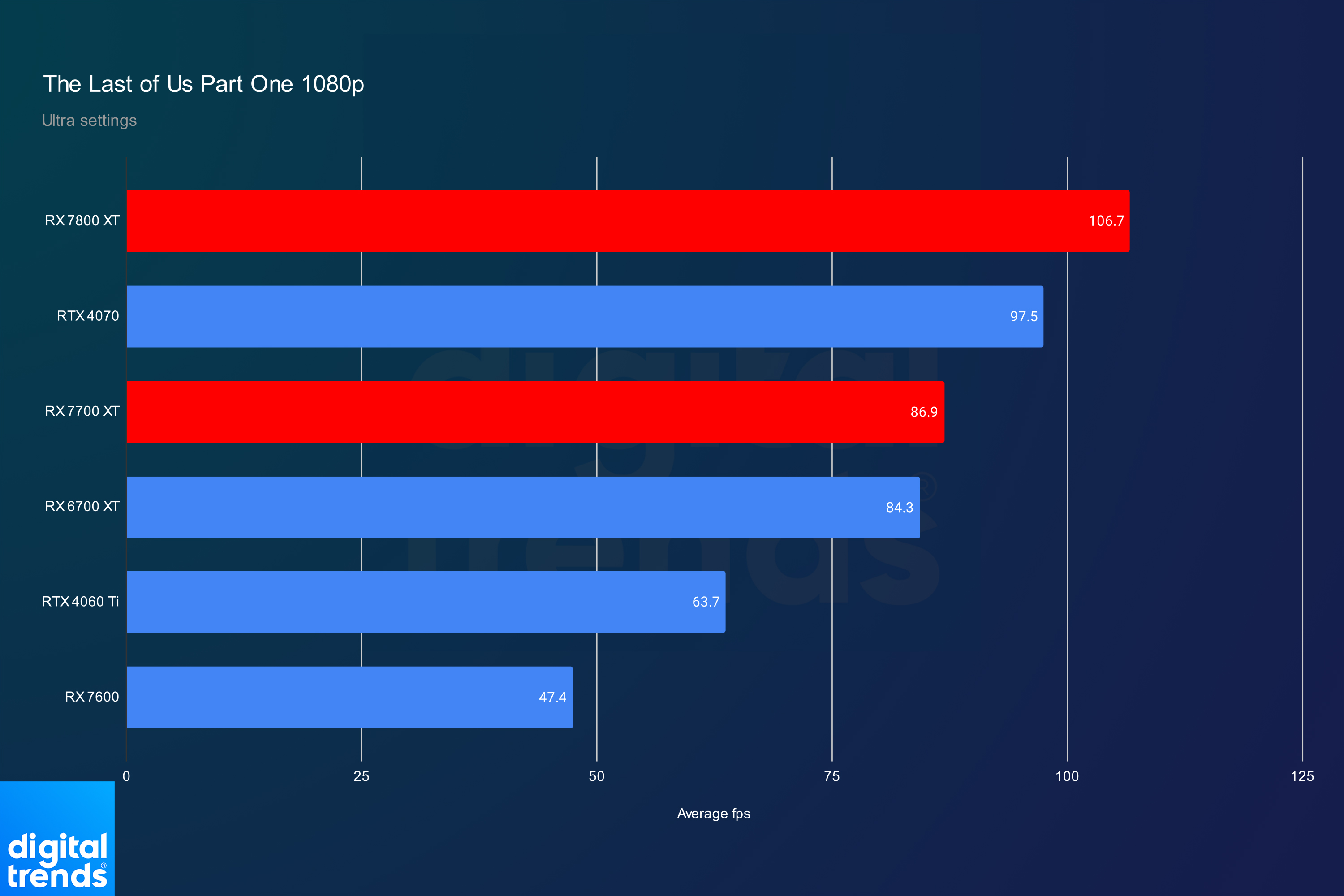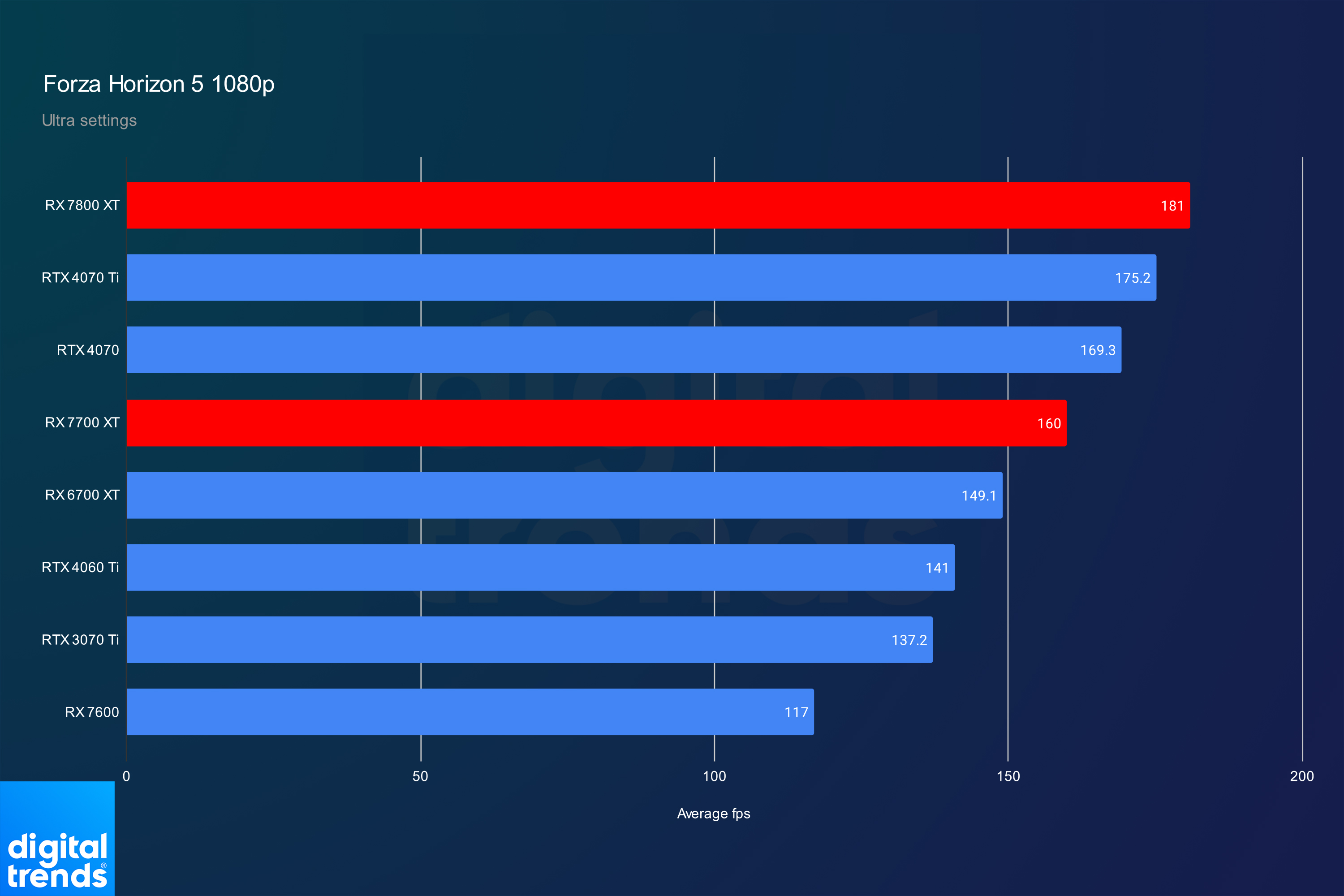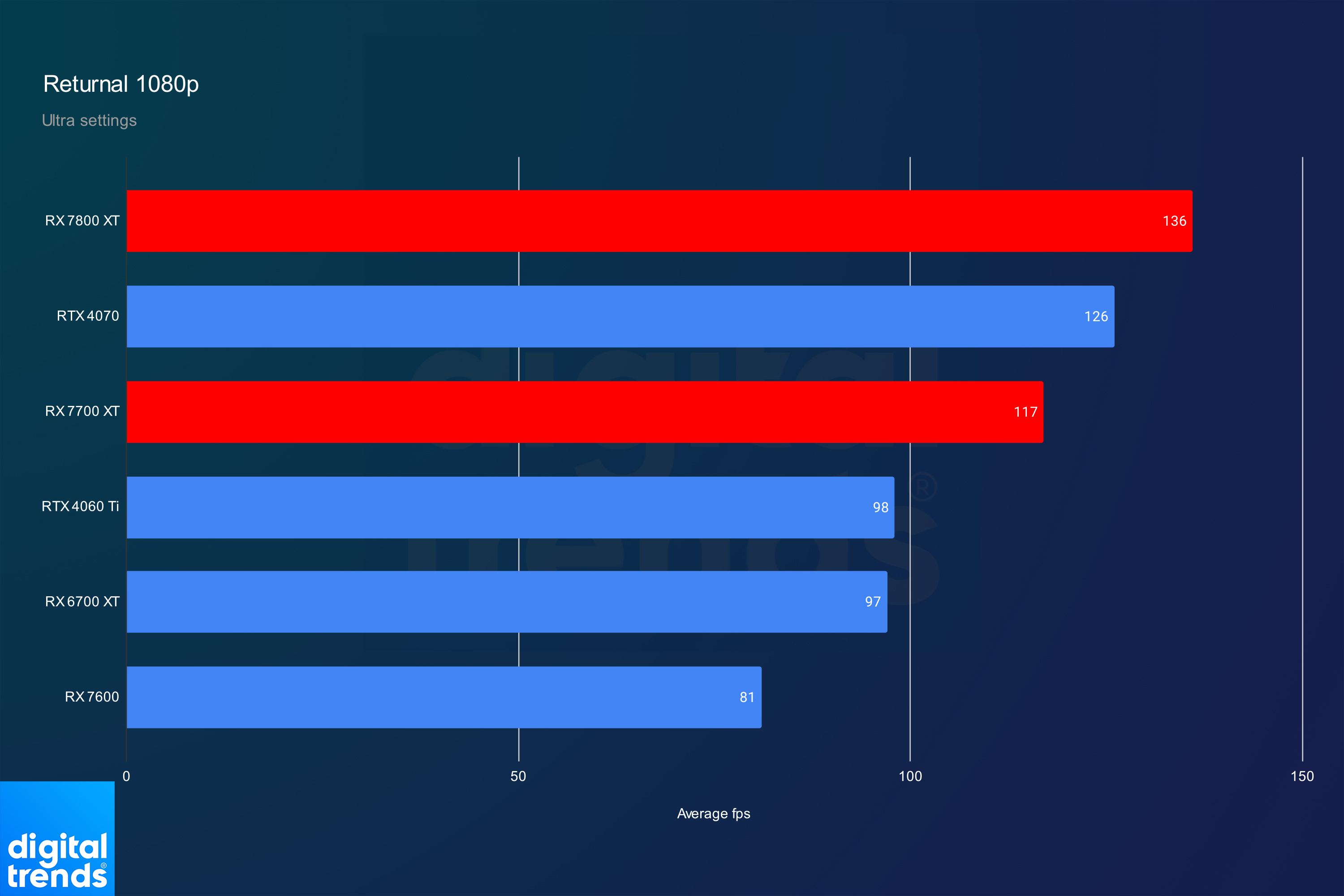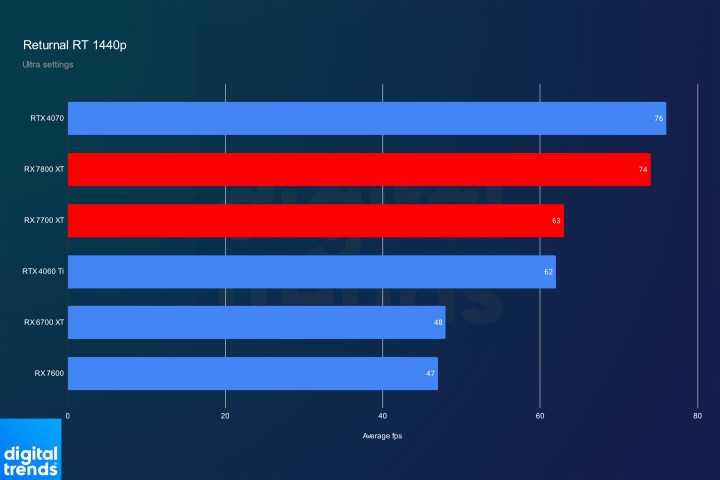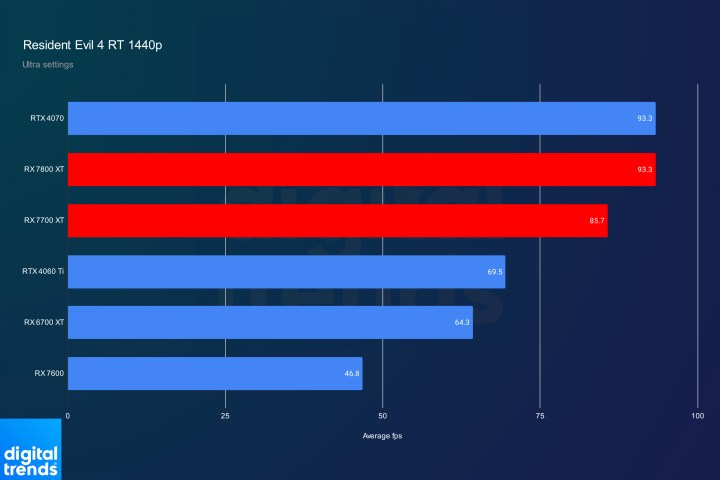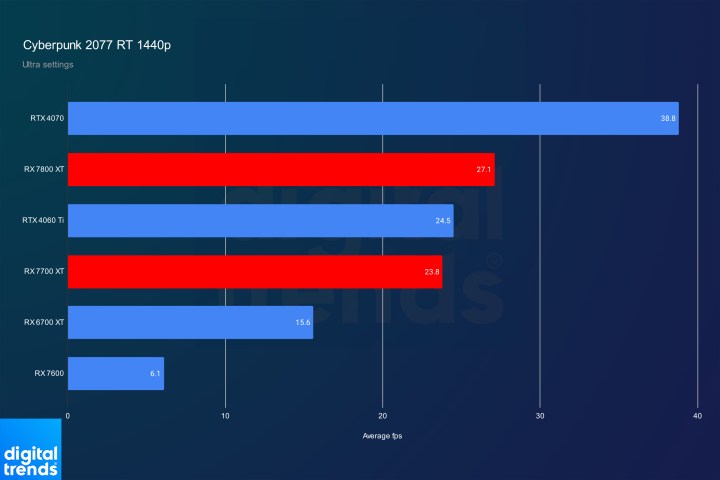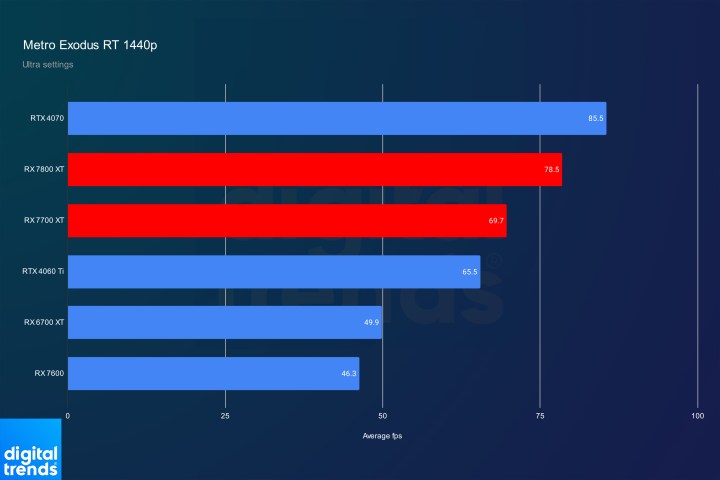
AMD RX 7800 XT
MSRP $500.00
“Faster and cheaper than the Nvidia competition, the RX 7800 XT and RX 7700 XT are excellent.”
Pros
- Reasonably priced
- 100-plus fps at 1440p
- Solid ray tracing performance
- Plenty of VRAM
- Standard 8-pin power
Cons
- No DLSS
- Still weaker than Nvidia with ray tracing
Graphics cards are a lot more expensive than they used to be, and that’s mainly due to Nvidia. Short of the RTX 4060, all of its current-gen cards are more expensive than their last-gen counterparts, sometimes by hundreds of dollars. With the RX 7800 XT and RX 7700 XT, AMD is hitting Nvidia where it hurts the most.
AMD’s two new GPUs are solid, with respectable gen-on-gen uogrades and competitive performance, but it’s the price that makes them so impressive. AMD actually cut prices compared to the previous generation, which is bad news for Nvidia’s current overpriced lineup.
AMD RX 7800 XT and RX 7700 XT specs

The RX 7800 XT and RX 7700 XT may be close in name to AMD’s recent RX 7600, but they’re a massive jump in specs. Both have nearly double the number of compute units, leading to a similar increase in both AI and ray tracing accelerators, and they come with a bump in memory up to 16GB.
| RX 7800 XT | RX 7700 XT | RX 7600 | |
| Compute units | 60 | 54 | 32 |
| AI accelerators | 120 | 108 | 64 |
| Ray tracing accelerators | 60 | 54 | 32 |
| Memory | 16GB GDDR6 | 12GB GDDR6 | 8GB GDDR6 |
| Memory speed | 19.5Gbps | 18Gbps | 18Gbps |
| Memory bus size | 256-bit | 192-bit | 128-bit |
| Game clock speed | 2.12GHz | 2.17GHz | 2.25GHz |
| Connection support | DisplayPort 2.1 | DisplayPort 2.1 | DisplayPort 2.1 |
| Total board power | 263 watts | 245W | 165W |
| List price | $500 | $450 | $270 |
That memory spec is important, as PC gamers have learned over the past year. The RX 7600, despite being a 1080p graphics card, still showed some limitations with its 8GB of VRAM on a 128-bit bus. The RX 7700 XT matches the last-gen version of this card with 12GB on a 192-bit bus, while the RX 7800 XT jumps to 16GB on a 256-bit bus.
From a competitive standpoint, that extra VRAM can make a big difference. The $400 RTX 4060 Ti comes with 8GB of VRAM, and you’ll need to spend between $450 and $530 if you want the same card with 16GB. Similarly, the $600 RTX 4070 comes with 12GB of VRAM, but even that amount is being challenged in some games at higher resolutions, including Resident Evil 4 and The Last of Us Part 1.
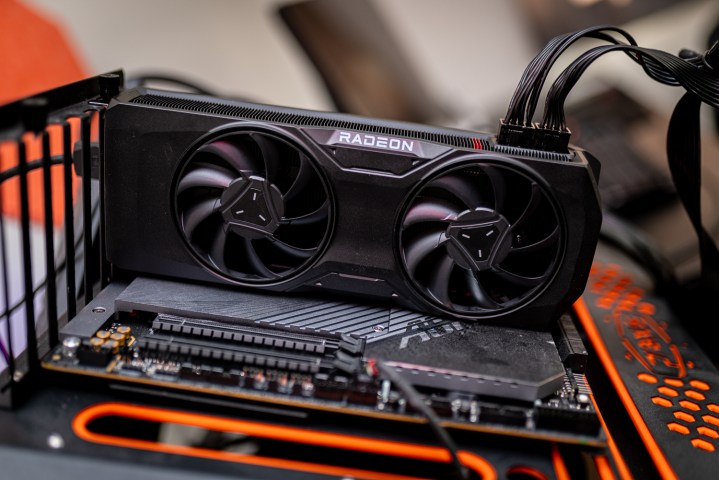
The pricing discussion is interesting here, too. The RX 7800 XT is $500, putting it in competition with the 16GB RTX 4060 Ti and the RTX 4070. At only $50 less, the RX 7700 XT is also competing with the 16GB RTX 4060 Ti, as well as the $400 8GB model. This isn’t how things are usually, and I’d expect to see each of these cards compete with cards that are a notch up in Nvidia’s lineup.
Maybe that was the original intention — Nvidia’s pricing has been out of sorts this generation, after all. As I’ll dig into below, with the RX 7800 XT and RX 7700 XT, Nvidia’s loss is AMD’s win here. These cards may have otherwise been middling and unexciting, but AMD is essentially able to compete with much weaker cards from Nvidia simply due to the fact that Nvidia is charging more for them.
Synthetic performance
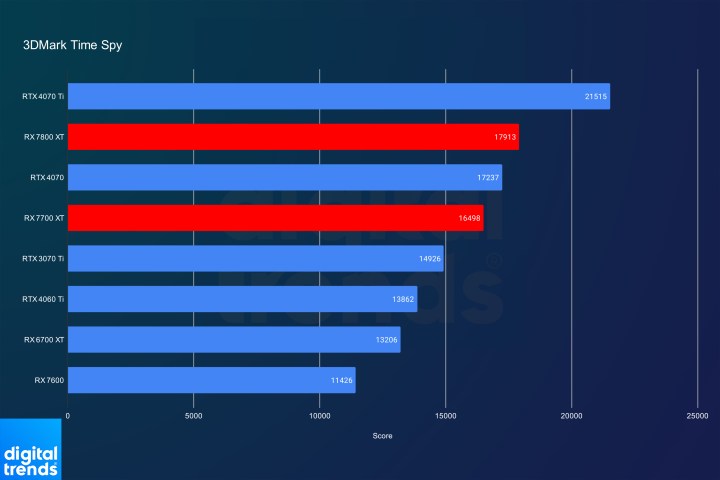
Before getting into real games, let’s lay some groundwork. In 3DMark Time Spy, the RX 7800 XT ends up a minor 4% faster than the RTX 4070. A lead is still a lead here, though, especially considering the RX 7800 XT is $100 cheaper than the RTX 4070. The RX 7700 XT is the real winner over the 8GB RTX 4060 Ti, though, coming in a clean 19% faster than Nvidia’s GPU.
That’s roughly the same as the RX 7700 XT’s gen-on-gen improvement over the RX 6700 XT as well. In Time Spy, which is a 1440p DirectX 12 gaming benchmark, AMD is coming out clearly ahead.
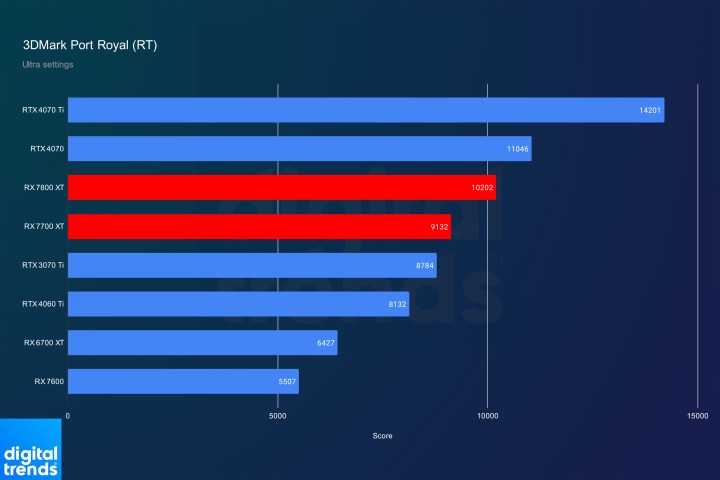
That story changes a bit in Port Royal, which is 3DMark’s ray tracing benchmark. As expected, the RTX 4070 and RX 7800 XT trade places, with Nvidia’s card leading by nearly 8%. But then there’s the RX 7700 XT. It’s faster than the RTX 4060 Ti, and not by an insignificant margin. It came out 12% ahead of Nvidia’s card.
I’ve never seen an AMD GPU beat an Nvidia GPU in ray tracing, at least when comparing two cards from the same class. This isn’t a fluke, either, as I’ll get into with my ray tracing benchmarks later.
4K performance
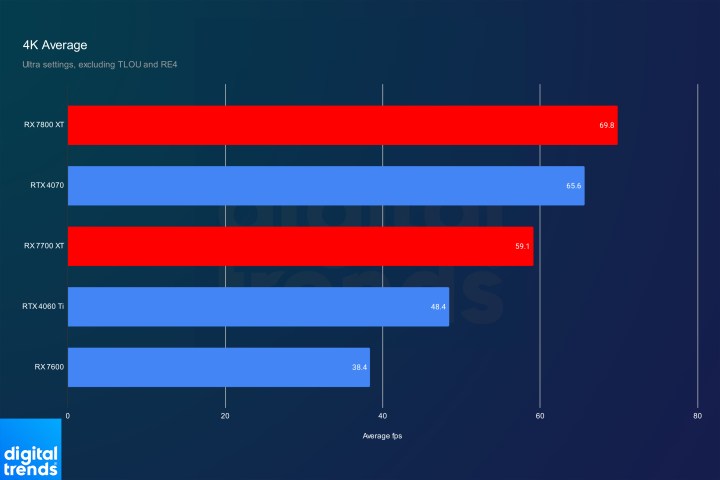
AMD hasn’t billed the RX 7800 XT and RX 7700 XT as 4K GPUs, and although you could push them to 4K, they’re better suited for 1440p. Overall, the RX 7800 XT ends up around 6% faster in 4K than the RTX 4070, while the RX 7700 XT is a massive 27% faster than the 8GB RTX 4060 Ti.
It’s worth pointing out that this average doesn’t include The Last of Us Part 1 and Resident Evil 4, which I don’t have enough data for at 4K. Including those games likely wouldn’t favor Nvidia’s GPUs due to the fact that they’re both heavily limited by VRAM. Still, keep that in mind if you’re comparing the numbers between different resolutions.
AMD’s RDNA 3 graphics cards excel at higher resolutions, and that’s exactly what we see with the RX 7800 XT and RX 7700 XT. As you can see in Forza Horizon 5 and Assassin’s Creed Valhalla, the RX 7800 XT actually matches the $800 RTX 4070 Ti. In these games, the RX 7700 XT approaches the RTX 4070, and it absolutely clobbers the 8GB RTX 4060 Ti.
These two games favor AMD’s GPUs, and that’s apparent once you start looking at other titles. In both Cyberpunk 2077 and Horizon Zero Dawn, the RX 7800 XT claims a marginal lead over the RTX 4070, while the RX 7700 XT shoots ahead of the RTX 4060 Ti.
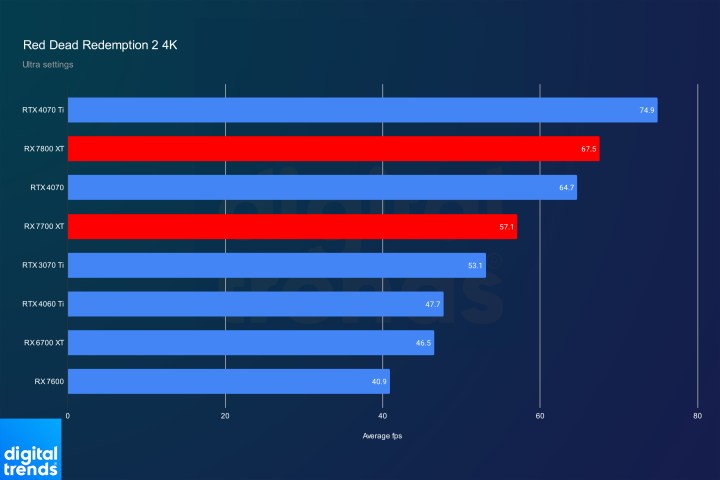
Red Dead Redemption 2 is probably the best showcase of what you can expect out of these cards at 4K, though. The RX 7800 XT ends up about 4% faster than the RTX 4070, while the RX 7700 XT is nearly 20% faster than the RTX 4060 Ti, likely due to that card’s constrained memory interface.
1440p performance
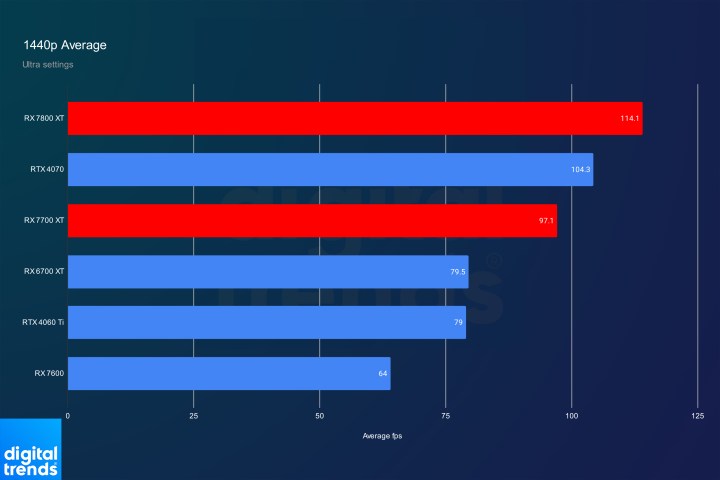
AMD says the RX 7800 XT and RX 7700 XT shine at 1440p, and my testing backs that up. The RX 7800 XT takes a clear lead over the RTX 4070, ending up 9% faster on average. Even more impressive is the RX 7700 XT, which is 23% faster on average based on my testing.
Those VRAM-limited games I mentioned in the last section are back in action here, which is why the 8GB RTX 4060 Ti fared so poorly. The 16GB model would surely post higher numbers, but I don’t have that GPU available to test. It’s a very low-volume release from what I can see, and although there are some models selling for $450, many still run for $500 to $530.
There are far more 8GB RTX 4060 Ti’s in the wild, it seems, and that card just can’t hold up to the RX 7700 XT. AMD’s GPU is a full 36% faster in The Last of Us Part 1 and nearly 28% faster in Resident Evil 4. The RX 7800 XT leads the RTX 4070 in both games as well, though by less significant margins.
It’s not just these games, though, and both the RX 7800 XT and RX 7700 XT have some big wins elsewhere. In Returnal, Assassin’s Creed Valhalla, and Forza Horizon 5, both cards are clearly ahead of the competition from Nvidia, with the RX 7800 XT once again approaching the level of an RTX 4070 Ti.
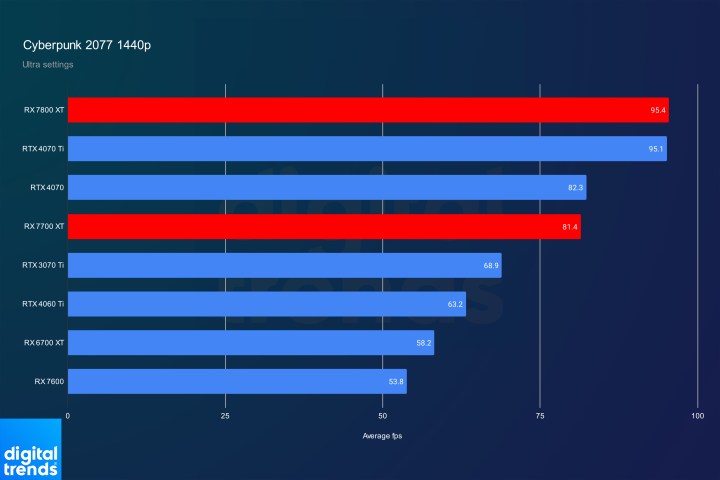
The most shocking win came in Cyberpunk 2077, though, where the RX 7800 XT actually managed a win over the $800 RTX 4070 Ti. It’s a fraction of a frame, but it goes to show how much of a pricing correction AMD’s two new GPUs represent.
Those are the big wins, but Red Dead Redemption 2 and Horizon Zero Dawn tell the overall story of AMD’s two new GPUs. The RX 7800 XT is once again a hair faster than the RTX 4070, while the RX 7700 XT shoots ahead of the RTX 4060 Ti.
1080p performance
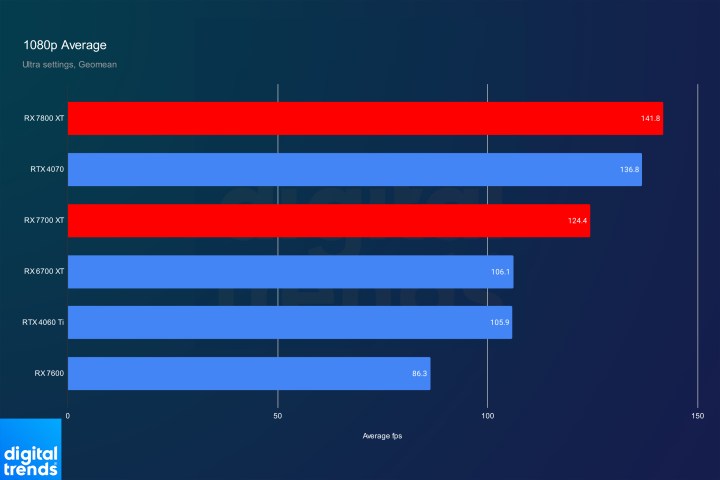
The RX 7800 XT and RX 7700 XT aren’t built for 1080p gaming, and it’s by far the weakest resolution for both cards. Still, if you look at the average across my test suite, the RX 7800 XT manages a 4% lead over the RTX 4070, while the RX 7700 XT is 17% faster than the RTX 4060 Ti. Once again, that’s an almost identical gen-on-gen improvement when you compare the card to last-gen’s RX 6700 XT.
There are some situations where AMD loses with the RX 7800 XT at 1080p, though. In Cyberpunk 2077, Horizon Zero Dawn, and even Resident Evil 4, the RTX 4070 holds a minor lead over AMD’s new card. The RX 7700 XT still manages to impress here, coming in just behind the RX 7800 XT and clearly ahead of the RTX 4060 Ti.
It’s worth highlighting these games because AMD’s new cards lead in everything else. Even down at 1080p, where the RX 7800 XT and RX 7700 XT seem their weakest, most games tell the same story we’ve seen at higher resolutions.
Ray tracing and FSR
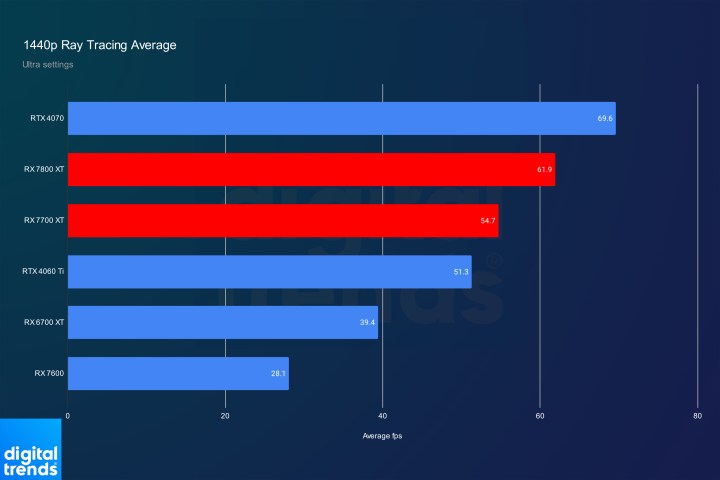
AMD has always struggled with ray tracing compared to Nvidia, and the RX 7800 XT and RX 7700 XT don’t change that story. However, they certainly tip the scales in AMD’s favor, which no graphics card has been able to do up to this point. At 1440p, we can see a repeat of Port Royal. The RX 7800 XT is 11% behind the RTX 4070, but the RX 7700 XT is 7% ahead of the RTX 4060 Ti.
It’s one thing for AMD to claim a lead in a dedicated ray tracing benchmark, but in real games? I’ve never seen that before. The leads aren’t minor, either. You can see the RX 7700 XT shoot ahead in Resident Evil 4, and the RX 7800 XT perfectly keep pace with the RTX 4070. The same is true in Returnal.
The situation changes in Metro Exodus and Cyberpunk 2077, however. In these games, the RX 7700 XT matches the RTX 4060 Ti, while the RX 7800 XT takes a clear back seat to the RTX 4070. Still, you don’t need to squint to see that AMD has made improvements in the ray tracing department. After years of promising, it seems AMD is finally ready to be competitive with Nvidia in ray tracing.
I won’t retread ground here, but you can slide through my 1080p benchmarks above. They show similar results as 1440p.
Another factor to consider here is AMD’s FidelityFX Super Resolution (FSR). Or, in particular, the lack of Nvidia’s Deep Learning Super Sampling 3 (DLSS 3). For the problems DLSS 3 has, it can still multiply frame rates on RTX 40-series GPUs, which can trounce the leads AMD has with its two new GPUs.
AMD has promised FSR 3 will do something similar, but we don’t have it yet. There’s a chance it won’t hold up to DLSS 3, and it’s hard to base a buying decision on a feature that we don’t have in hand yet. That said, AMD says FSR 3’s Fluid Motion Frames will be available through the driver, potentially allowing the RX 7800 XT and RX 7700 XT to apply the feature to thousands of games.
Based on what we have today, DLSS is still a major reason to buy an Nvidia GPU over AMD. However, that advantage mainly comes up when only a little bit of money is on the line. In the case of the RX 7800 XT and RX 7700 XT, you’re giving up performance and spending more money with the competition from Nvidia, and all to unlock DLSS. In that case, the feature loses its luster.
Nvidia’s loss, AMD’s win
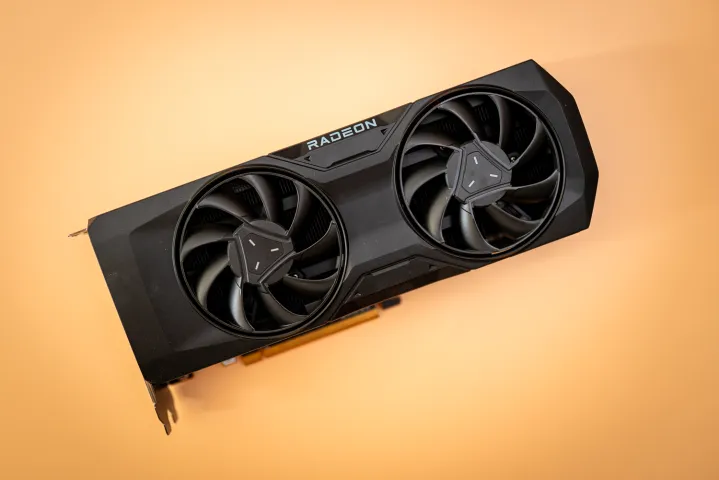
I wonder how the situation with the RX 7800 XT and RX 7700 XT would be different if Nvidia hadn’t gone off the deep end with its pricing. AMD’s two new cards are decent on their own, but they really shine given the pace Nvidia has set with its current-gen pricing.
It’s hard to recommend anything else at this price. Outside of the RTX 4060 Ti and RTX 4070, your other options are AMD’s last-gen RX 6800 XT and Nvidia’s RTX 3070 Ti, both of which aren’t as powerful as AMD’s new cards. You can score a deal on the RX 6950 XT, but even then, you’re spending about $150 more than the RX 7800 XT for roughly the same performance.
AMD has stumbled this generation up to this point, never releasing a bad product, but never fully taking the task to Nvidia. The RX 7800 XT and RX 7700 XT break that pace, and they’re easy to recommend because of it.
Editors’ Recommendations
